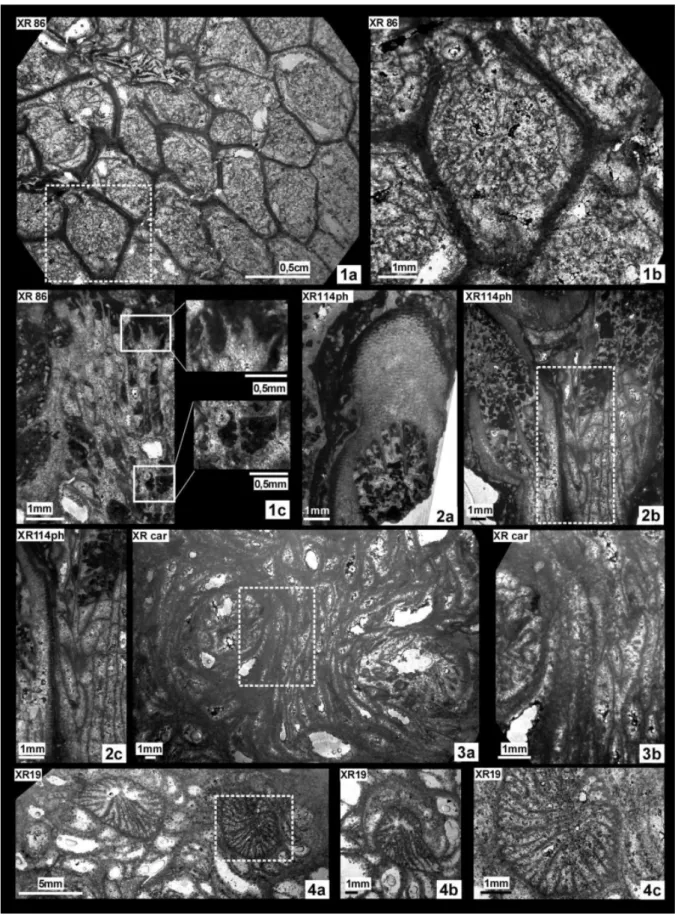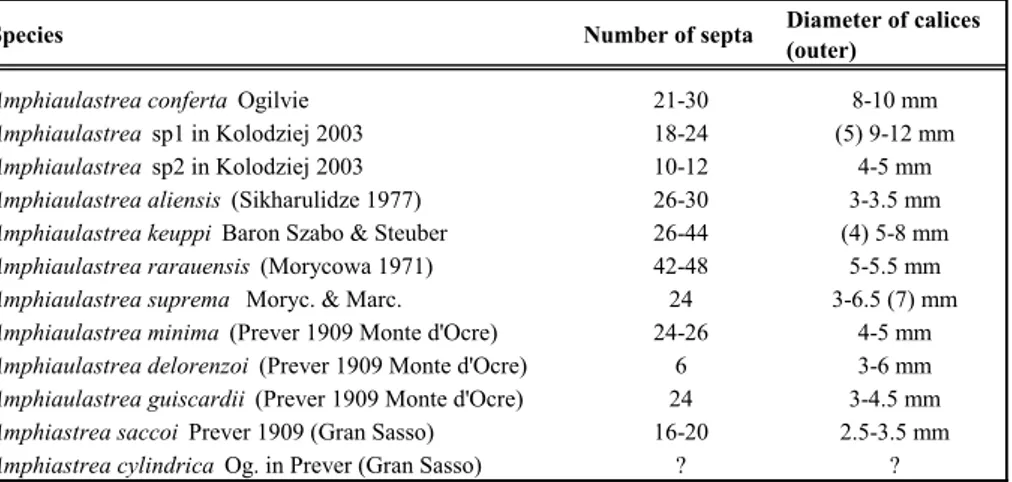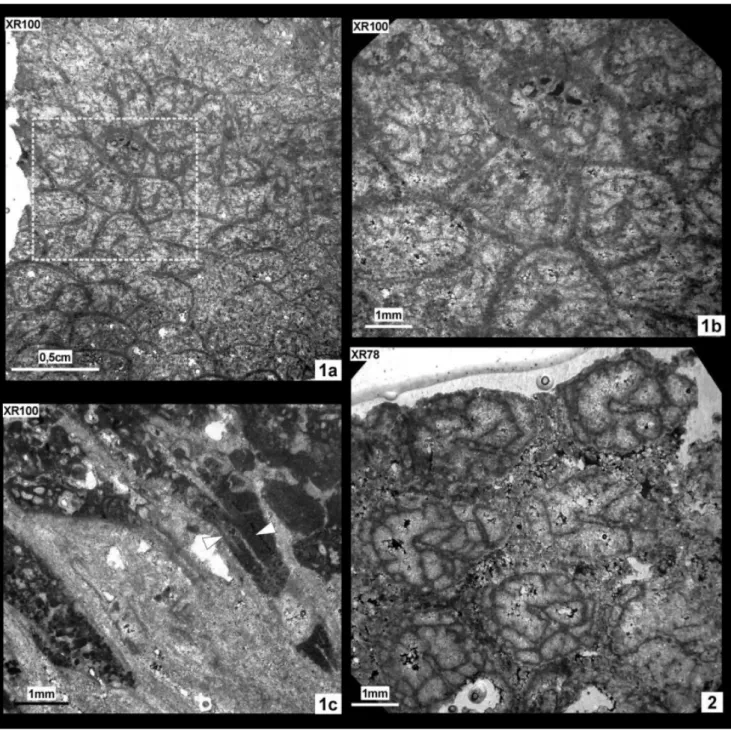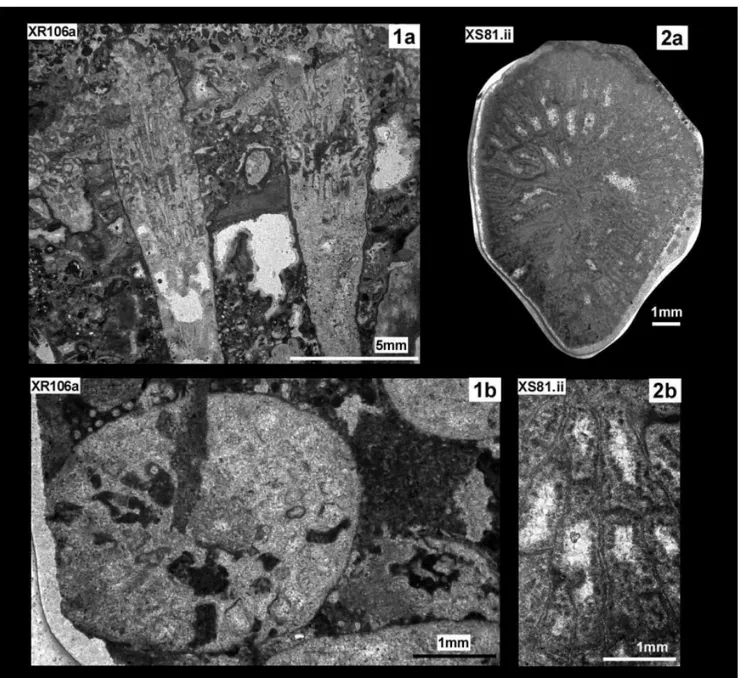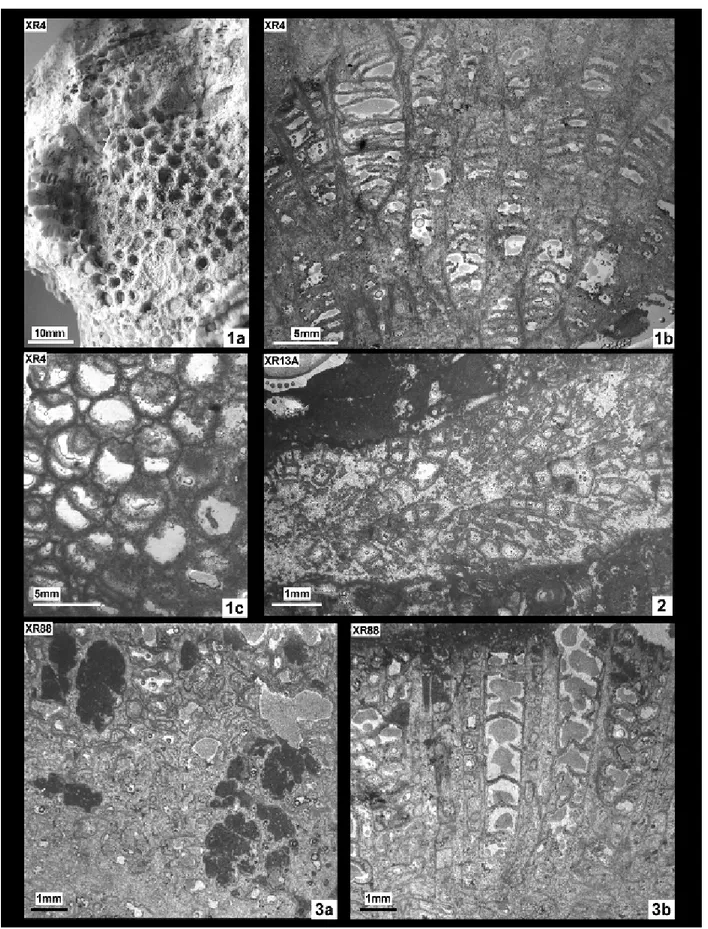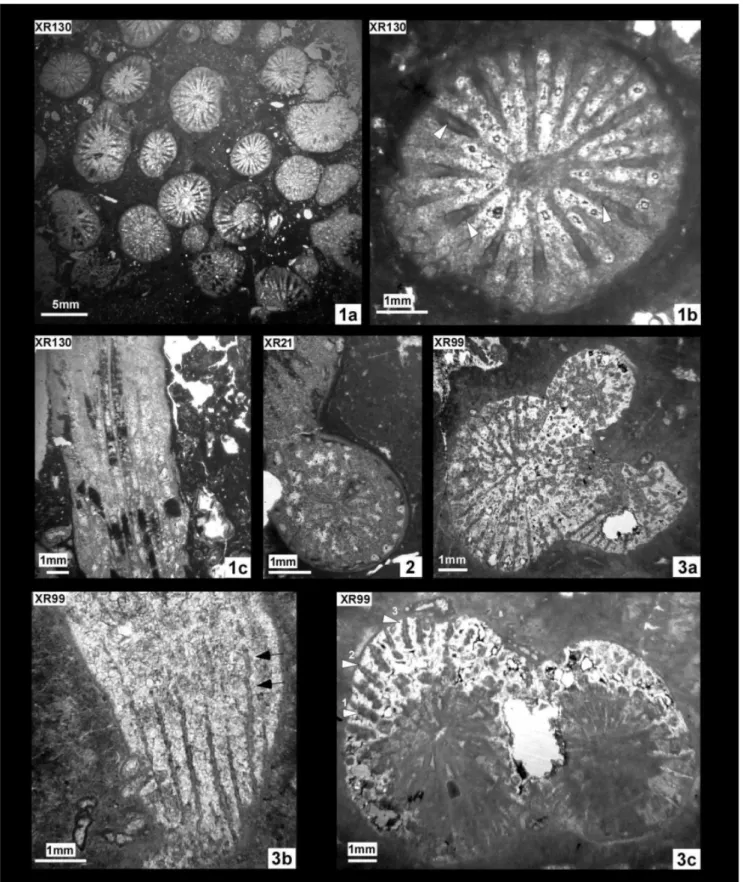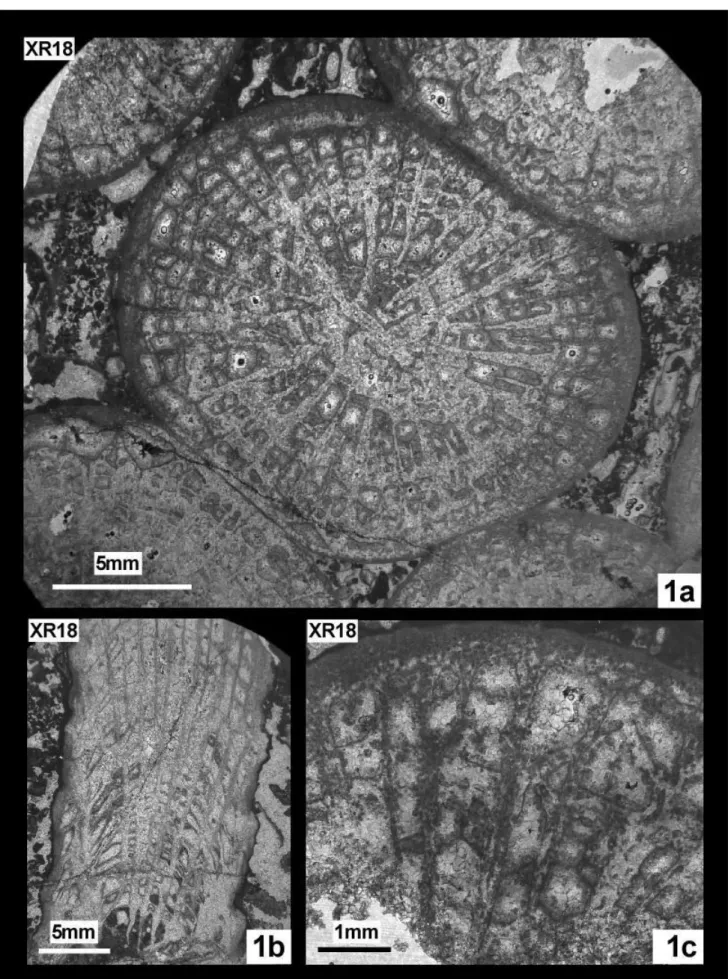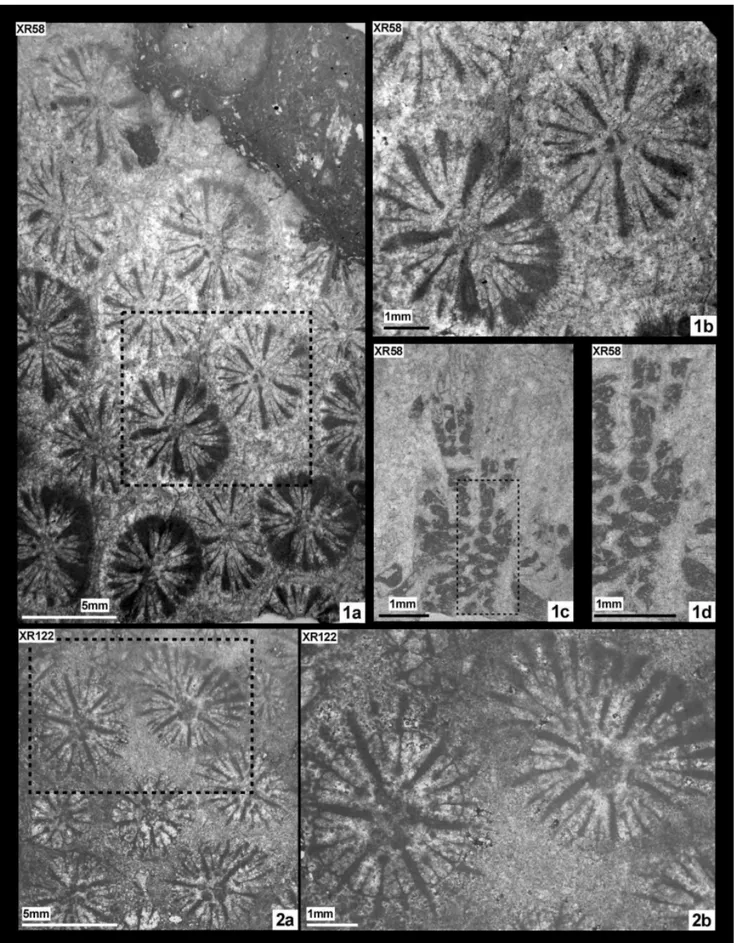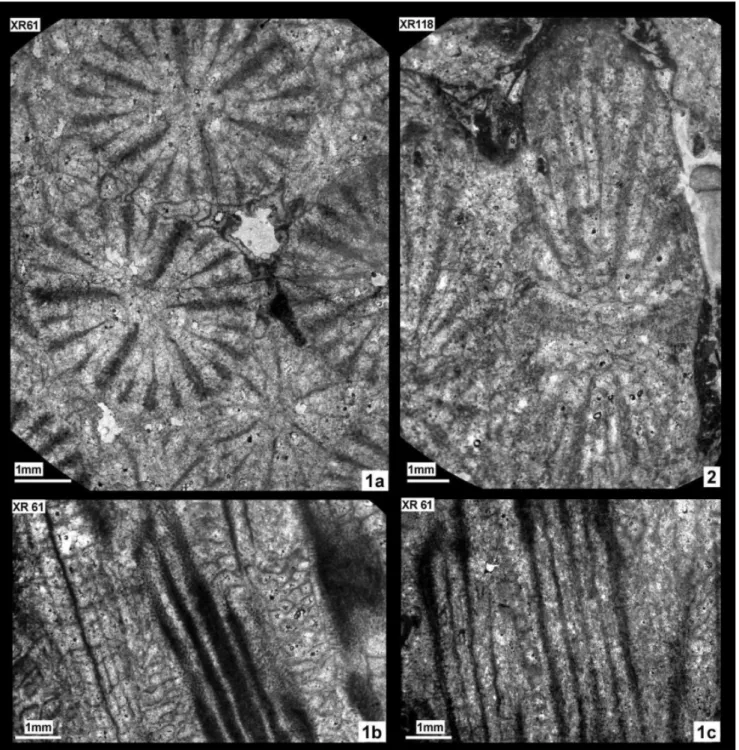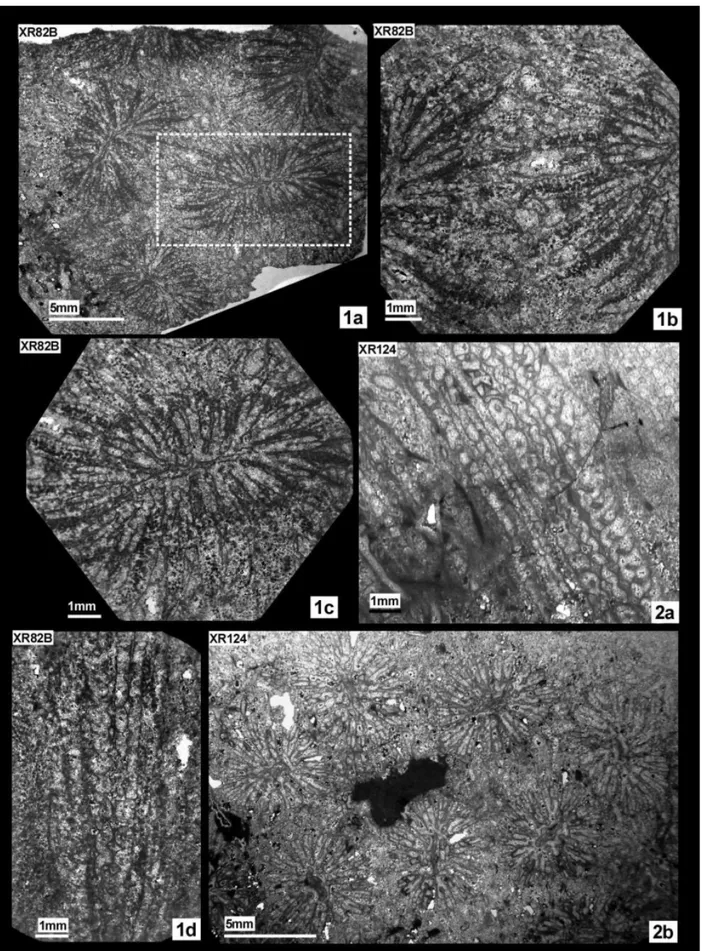IntroductIon
Jurassic corals are reported as one of the main facies components of shallow water systems, devel-oped in different depositional setting, from inner la-goon to distal slope (Roniewicz & Roniewicz 1971; Eliášová 1981, 2008; Turnšek et al. 1981; Geister & Lathuilière 1991; Leinfelder 1993; Insalaco et al. 1997; Insalaco 1999; Leinfelder 2001; Helm et al. 2003; Olivier et al. 2004; Lathuilière et al. 2005; Iva-nova et al. 2008; Olivier et al. 2012; Martin-Garin et al. 2007, 2012). Moreover, Late Jurassic coral com-munities are systematically documented both from the northern Tethyan margin reef and from car-bonate platforms of Tethyan domains (Beauvais, 1973, Roniewicz 1976; 2008; Errenst 1990; Turnšek 1997; Kołodziej 2003; 2015; Morycowa 2012; among
many others). Nevertheless, comprehensive works that combine coral taxonomy and sedimentology and addicted to the paleoecological characterization of coral communities are rare (e.g. Turnšek et al. 1981; Leinfelder et al. 1996; Nose & Leinfelder 1997; Helm et al. 2003; Lathuilière et al. 2005; Ivanova et al. 2008). Paleoecological reconstruction usually are obtained from the analysis of 1D-stratigraphic logs (Leinfelder 1993; Lathuilière et al. 2005; Olivier et al. 2004, 2012; Morycowa 2012), 2D-metric-scale out-crops (e.g. Dupraz & Strasser 2002; Ricci et al. 2012) or even from reworked olistoliths (e.g. Eliášová 1981; Eliáš & Eliášová 1984; Kołodziej 2015; Hoffmann et al. 2017). In these areas, coral paleoecological recon-structions are derived from analyses of stratigraphic architecture and facies where corals are incorporated and by investigation of communities associated, e.g. microencrusters, bivalves, sponges and foraminifera. Reef complex depositional models are thus
com-CORAL COMMUNITIES, ZONATION AND PALEOECOLOGY OF AN UPPER JURASSIC REEF COMPLEX (ELLIPSACTINIA LIMESTONES, CENTRAL APENNINES, ITALY)
CRISTIANO RICCI1, BERNARD LATHUILIÈRE2 & GIOVANNI RUSCIADELLI1
1Dipartimento di Ingegneria e Geologia, Università “G. d’Annunzio” di Chieti-Pescara, Via dei Vestini 30, 66013, Chieti Scalo, Italy. E-mail:
[email protected]; [email protected]
2UMR CNRS 7566, Géologie et Gestion des Ressources Minérales et Energétiques (G2R), Université de Lorraine, CNRS, lab. GeoRessources
UMR 7359, BP 70239, 54506, Vandoeuvre-lès-Nancy Cedex, France; Université de Nancy I, BP 239, F 54506 Vandoeuvre-lès-Nancy cedex, France. E-mail: [email protected]
To cite this article: Ricci C., Lathuilière B. & Rusciadelli G. (2018) - Coral communities, zonation and paleoecology of an Upper Jurassic reef complex (Ellipsactinia Limestones, central Apennines, Italy) . Riv. It. Paleontol. Strat., 124(3): 433-508.
Abstract. This work describes and analyzes an original collection of fossil corals from the Ellipsactinia Limestones (Kimmeridgian-Tithonian), exposed in the Marsica area (central Apennines, Italy), focusing on taxonomy and paleoecology. 43 species grouped into 32 genera, 16 families and 9 suborders were identified. Astreoidogyra giadae nov. gen. nov. sp. (Rhipidogyridae) and Clausastrea eliasovae nov. sp. (Montlivaltiidae) are new taxa. Corals occur from the back reef to the reef crest, showing a marked zonation, expressed by a variation of coral cover and type, although the reef front and slope facies could not be sampled. The back reef is characterised by scattered medium-to-small colonies, with a relative high variety of colony shape, corallite arrangement types and high taxonomic diversity. Stylosmilia, Calamophylliopsis,
Intersmilia, Pleurophyllia, Bracthelia, Heliocoenia, Ogilvinella occur here among others. The inner reef flat records the highest
coral cover, with large robust branching, such as “Pseudocoenia”, Heliocoenia, Calamophylliopsis, and large dome-shaped meandroid, such as Psammogyra, Pruvostrastraea, Eugyriopsis) colonies. Within the external reef flat and the reef crest the coral cover is low and the stromatoporoid-bearing mounds dominate on the isolated coral bioconstructions. Controlling factors as bathymetry, hydrodynamic disturbances, abrasive currents, background sedimentation and morphological irregularities of the depositional profile are considered to explain the observed coral zonation. High diversity and low dominance indices are interpreted to result from reef complex heterogeneity, which should have influenced the formation of different ecological niches and consequently the proliferation of a greater number of taxa in a relatively small area.
Keywords: Late Jurassic; Corals; Systematic; Ecology; reef; Apennines.
monly addressed through comparative studies of modern coral reefs, using a general uniformitarian approach (e.g. Eliášová 1981; Eliáš & Eliášová 1984; Bosence & Allison 1995; Lathuilière 2000; Lathu-ilière et al. 2005). Conversely, a direct observation of distribution pattern of corals along a deposition-al profile, where cordeposition-als and their environmentdeposition-al and spatial context is well-constrained, is usually not the rule, because of the rareness of well-preserved large portion of reef complexes.
The coral collection presented in this work is from the Ellipsactinia Limestones of the Marsica area (Central Apennines, Italy), a well known geolog-ical region belonging to the Intra-Tethys domain, for which the sedimentological characters and the depo-sitional model are well documented (Rusciadelli et al. 2011). The original coral collection represents a sig-nificant step forward in the knowledge of
paleonto-logical study of Jurassic corals from the Apennines, after the pioneer work of Prever (1909). The oppor-tunity to observe, along a well constrained deposi-tional profile, the distribution pattern of the coral community classified at the species level, leads to a better understanding of the paleoecological relation-ships between significant features of coral skeletons (e.g. size, external morphology, microarchitecture) and the environmental conditions influencing their growth.
This work allows the following questions to be approached: 1) How Late Jurassic corals of In-tra-Tethys domain were distributed with respect to a zoned reef complex? 2) Which skeleton characters are mainly affected by changes in depositional envi-ronment? 3) Are there coral taxa significantly influ-enced in their distribution by changes in bathymetry, hydraulic energy and rate of sediment reworking? Fig. 1 - Geological framework. A) schematic paleogeographic map of Tethys during the Late Jurassic, displaying the location of the studied
area (modified after Dercourt et al. 2000). The shallow water carbonates of the central Apennines belong to the Intra-Tethyan plat-form system, developed on the continental margins of Adria, far from continental-derived terrigenous input. B) Biozonation and lithostratigraphy of the Upper Jurassic-Lower Cretaceous platform margin of the central Apennines and of the studied area. See text for further explanation. C) Geological map of the central Apennines and the Gargano area, showing the distribution pattern of Mesozoic carbonate facies. The studied area is located in the outer sector of the central Apennines, where intraplatform basins dissect the main platform bank. Compiled from Servizio Geologico d’Italia, 1934, 1942, 1955, 2006a, b, c, d; Accordi et al. 1988; Bonardi et al. 1988; Vezzani & Ghisetti 1997. D) Simplified geological map of the Marsica area (modified after Accordi et al. 1988; D’Andrea et al. 1991). The studied area characterises the internal (western) platform margin of the Genzana intraplatform basin.
G
eoloGIcal frameworkShallow-water carbonates of central Apen-nines belong to the complex system of Intra-Teth-yan carbonate platforms developed on the
conti-nental margins of Adria, far from siliciclastic input, in an intermediate position between the European and African continents (Fig. 1A) (e.g. Dercourt et al. 2000; Golonka 2002; Stampfli & Borel 2002). During the Late Jurassic, these isolated platforms Fig. 2 - Geological section and depositional profile of Ellipsactinia Limestones. A) Panoramic view of the Serra del Carapale displaying a
nat-ural geological transect perpendicular to platform margin. It shows the vertical stratigraphic relationships between the Upper Jurassic margin succession of the Ellipsactinia Limestones and the inner platform succession of the Carapale Limestones, and the lateral rela-tionships among the different lithostratigraphic units (CCU, CSU, SSU) of the Ellipsactinia Limestones. The Nerineids and Diceratids Horizon (NDH) and the Upper Tithonian Unconformity (UTU) mark the vertical transition between the platform margin and the inner platform successions. B and C) Depositional profile and bathymetry of the studied Upper Jurassic reef complex. The deposi-tional profile (C) has been reconstructed through the restoration of a geological cross section (B), oriented in a SW-NE direction. The vertical exaggeration used here is 1,33. Two main sectors, displaying very different morphologies and water depths characterise the development of the depositional profile throughout the reef complex. Reef zones correspond to different sub-environments defined by distinct abiotic characteristics, peculiar biotic assemblages and characteristic hydrodynamic regime. See text for further description. D) Graphic description of depositional regime and hydraulic competence (actual and theoretical) and their effects on sediments pro-duced. Concepts and graphics drawn on the papers of Pomar (2001) and Pomar & Kendall (2008).
were rimmed by wide reef areas with highly di-verse biotic communities, dominated by corals and stromatoporoids, with high debris production and poor in micrite (Leinfelder et al. 2002, 2005). These platform margin successions, which bear different formational names, are commonly and informally designated “Ellipsactinia Limestones”.
In the central Apennines, the Ellipsactinia Limestones are referred to the Crescentiella
(=Tubi-phytes) morronensis biozone (Kimmeridgian-Tithoni-an) (cf. Chiocchini et al. 1994; 2008) (Fig. 1B), and are embedded between Middle and Upper Jurassic platform margin deposits at the base, and upper-most Tithonian-Lower Cretaceous inner platform and platform margin successions at the top (Bigi 2006; Chiocchini et al. 1994; Fumanti 2006; Rusci-adelli 2006).
The study area is located in the Marsica re-gion (Fig. 1C and 1D), which is characterised by a series of superposed tectono-stratigraphic units, stacked during the Miocene-Pliocene Apennin-ic orogenesis (e.g. Ghisetti & Vezzani 1997). The Ellipsactinia Limestones are here exposed over an
area of ca. 6 km2, with a thickness of
approximate-ly 200-250 m, along a natural transect about 3 km long, perpendicular to the platform margin (Fig. 1D). The lower boundary is not exposed, where-as the upper boundary coincides with a major un-conformity (Upper Tithonian Unun-conformity) that abruptly separates the Ellipsactinia Limestones from the overlying inner platform succession (Ca-rapale Limestones of Rusciadelli et al. 2011) (Fig. 1B, 2A, B). The latter is dominated by peritidal fa-cies and by a basal horizon (Nerineids and Dicerat-ids Horizon of Rusciadelli et al. 2011) a few to 20 m thick composed of bio-lithoclastic calcirudites with abundant black pebbles, large mollusks (gas-tropods and diceratids), some corals and algal bio-constructions (Neoteutloporella socialis).
Recently, Rusciadelli et al. (2011) have sub-divided the Ellipsactinia Limestones into three distinct units, labelled: Corals and Chaetetids Unit (CCU), Corals and Stromatoporoids Unit (CSU), and Stromatopores Unit (SSU, here modified as Stromatoporoids Unit). These units are distributed according to lateral heteropic relationships, as une-quivocally indicated by their position below the Up-per Tithonian Unconformity (Fig. 2). The transition between them is quite rapid and it occurs within a few tens to hundred metres wide belt (Fig. 2).
r
eefprofIleandreef zonesUsing the Upper Tithonian Unconformity as reference surface, Rusciadelli et al. (2011) have re-constructed a tract of the reef profile about 3 km long, developed perpendicular to the platform mar-gin (Fig. 2C). An approximate bathymetric gradient has been assessed, taking as datum the highest area along the depositional profile and evaluating the rel-ative changes in depth along the profile. Based on morpho-bathymetric characteristics, the reef com-plex has been subdivided into three zones: the back reef, the reef flat and the reef crest (Figs 2C and D).
The back-reef corresponds to the deepest and most protected area, extending for about 1.7 km and showing an irregular topography, defined by deeper and higher morphological tracts, with a difference in height of roughly 20-30 m. The main reef building organisms are corals and chaetetids (cm- to dm- sized calcareous sponges, characterized by rigid cluster of tubes with a vertical develop-ment interrupted by a series of horizontal planes (tabulae), in life position or toppled, isolated or or-ganised in structures formed by several specimens. These are poorly developed in height and scattered in bio-lithoclastic debris. Chaetetids are isolated or organised in clusters of few specimens. Skeletons are locally encrusted by thin (few mm thick) micro-encruster- and microbial-bearing crusts, but they are not bound. Grains are poorly sorted, ranging in size from mud (micritic matrix of packstone) to boulders (large fragments or isolated toppled corals and chaetetids), with very fine to fine grain size be-ing prevalent.
The reef flat corresponds to the topographi-cally more uniform tract of the depositional profile that gently slopes towards the back-reef (Fig. 2). It represents a partially protected area for a length of about 1 km, shallower than the back-reef, (Figs 2C and D). In a more inner area, adjacent to the back-reef, the biotic community is dominated by a true, but discontinuous framework, distributed along a belt a few meters wide parallel to the platform mar-gin (Figs 2C and D). These bioconstructions char-acterise the more internal portion of a bioclastic sand-apron, where corals and stromatoporoids are dispersed mainly as large fragments. In correspond-ence with this narrow belt, coral colonies reach their maximum concentration and largest dimensions. Stromatoporoids are frequent as fragments or
scat-tered isolated specimens. Sediment is well-washed, fairly well-sorted and reworked; thick cements are frequent. The prevailing grain size is medium- to coarse-grained sand; the finer fraction (lime mud) disappears and the very fine- to fine-grained sand only occurs within cavities of dense coral assem-blages. These features suggest that hydraulic compe-tence was able to rework and export grain sizes up to medium-sand (Figs 2C and D).
The reef crest extends for a few hundred of meters in the outermost part of the reef complex (Fig. 2). The biotic community is dominated by stromatoporoids with subordinate small chaetetids. Stomatoporoids show parallel (laminae) and per-pendicular (pillars) skeletons elements in relation to the external surface, mostly represented by
Ellip-sactinia sp. and Sphaeractinia sp., and secondarily by small chaetetids. Other organisms are subordinate. The sediment is well-washed, sorted, coarse-grained sand; thick cements and cavities filled by cements are frequent. Hydraulic competence was sufficiently high to promote transport and dispersion of sedi-ment up to medium/coarse-grained sands (Figs 2C and D). The highest concentration and largest di-mensions of Ellipsactinia sp. and Sphaeractinia sp., in more or less densely packed clusters or as mound-shaped structures indicate shallower water, high hy-drodynamism and generally elevated abrasive con-ditions.
materIalandmethods
The collection contains over 103 coral samples and more than 220 thin sections. The coral collection is limited in number due to a poor state of preservation. For the same reason 79 samples of the collection are identified and described here. Coral samples and thin sections are housed at University “G. D’Annunzio” Chieti-Pescara, Laboratory of Stratigraphy (Collection Ricci C.-Rusciadelli G., Marsi-ca corals, label: XR). Corals were found in outcrop; only three speci-mens were collected from recent screes and are considered not strictly in place but belonging to the same stratigraphic unit. Corals show dif-ferent degrees of reworking: from corals in growth position to small coral rubbles. A thick patina of alteration or recristallisation prevents the coral identification and specimen classification in outcrops. Many corals have been discovered only after sawing. Conversely, in thin sec-tion, coral structures and microarchitectures are frequently preserved, while remains of microstructures are rather rare.
The geographic position of each collected coral was project-ed on the Upper Tithonian Unconformity, which marks the top of El-lipsactinia Limestones and is used as reference surface for the recon-struction of the reef profile (see Rusciadelli et al. 2011, for details). Seven corals collected are from the Nerineids and Diceratids Horizon that overlies the Ellipsactinia Limestones. They are included in the collection and described at species level, even if the coral distribution
and paleoecology referred to Nerineids and Diceratids Horizon are not addressed due to low coral occurrence in this unit.
Rarefaction curves and diversity indices were performed us-ing PAST open-source software (version 3.09, Hammer et al. 2001). Diversity indices are reported for the whole coral collection, for the Ellipsactinia Limestones and its subunits.
Remarks on coral systematic. The classification used in this
work represents an integration of different schemes (Alloiteau 1952; Chevalier & Beauvais 1987; Roniewicz 1976, Stolarski & Roniewicz 2001, Stolarski & Russo 2001; Morycowa & Roniewicz 1995). Am-phiastreina are included in the order Hexanthiniaria Montanaro-Gal-litelli, following Roniewicz (2008), Morycowa (2012), Melnikova & Roniewicz (2012) and Kołodziej et al. (2012). The other suborders are included in the order Scleractinia Bourne. However, arguments and discussions dealing with systematic classification at high levels (order, suborder and family) are out of the aim of this work, although some insights on ambiguous or problematic taxa assignments are dis-cussed in turn in the remarks. The characteristics of corals are illus-trated following the list of terms proposed by Beauvais et al. (1993) and re-structured by Bertling (1995). The meaning of terms is not completely established (for instance compare Alloiteau 1957; Stolar-ski 1996 and Baron-Szabo 2014). The ambiguities are herein avoided when necessary, following the on-going collective project (see corallo-sphere.org, Cairns et al. 2010).
The number of references in the synonymy is shortened and restricted to the citations in which the figuration allows a comparison and at least a compatibility. For the cases of type species is lacking the synonymy list is increased.
Measurement abbreviations. Re: radial elements. d: calicu-lar diameter expressed in millimetres. c-c: calicucalicu-lar distance expressed in millimeters. For both measurements the maximum (Max), mini-mum (Min) and mean (Mean) values are provided. The mean value corresponds to the arithmetic mean usually using more than five calices. s: number of radial elements corresponding to the sum of radial elements identified within a corallite. MI: maximum length of radial elements observed within the colony, expressed in millimetres. ml: minimum length of radial elements observed within the colony, expressed in millimeters. Ml and ml are not necessarily derived from the same corallite. tk: thickness of radial elements measured on trans-verse section in a median point between the inner edge and the wall or costae peripheral edges, expressed in millimetres. dsy: density of radial elements representing the maximum number of septa per millimetre, measured in transverse section and is independent from the size order hierarchy. df: diameter of fossa; f-f: distance between adjacent fossae. trab dsy: trabecular density, in transverse section. pen dsy: density of pennulae in longitudinal section. coll-coll: distance between two col-lines. Moreover, “coral-size” refers to the dimension of whole skele-ton or large fragments expressed as width x height, or diameter (in the cases of sub-circular colonies) observed in the field.
s
ystematIcsCorals samples come from two lithostrati-graphic units: Ellipsactinia Limestones and Ner-ineids and Diceratids Horizon of the Carapale Lime-stones (Fig. 1B). These units yielded 79 specimens, classified into 9 suborders, 16 families, 33 genera and 46 species (Tabs 1 and 2). Ellipsactinia Limestones
Order Hexanthiniaria Montanaro-Gallitelli, 1975 Sample Amphiastreina Alloiteau, 1952
Amphiastreidae Ogilvie, 1897
Amphiastrea Etallon, 1859 Amphiastrea basaltiformis Etallon, 1859 XR 86
Pleurophyllia Fromentel, 1856 Pleurophyllia cara Eliášová, 1975 XR 114ph
Amphiaulastrea Geyer, 1955 Amphiaulastrea sp. XR19*; XR car
Heterocoeniidae Oppenheim, 1930
Heterocoenia Milne Edwards & Haime, 1848 ? Heterocoenia cf. minutisima Reig Oriol, 1997 XR101L
Thecidiosmilia Koby, 1888 Thecidiosmilia morycowae Kołodziej, 1995 XR100; XR78 Intersmiliidae Melnikova & Roniewicz, 1976
Intersmilia Eliášová, 1974 Intersmilia aff. diaboli Eliášová, 1974 XR106a
Intersmilia sp. XRS8.1ii
Order Scleractinia Bourne, 1900 Stylophyllina Beauvais, 1980
Cyathophoridae Vaughan & Wells, 1943
Cyathophora Michelin, 1843 Cyathophora bourgueti (Defrance), 1826 XR4
Cyathophora sp. XR13A*, B*
Cyathophora aff. parva XR88
Caryophyliina Vaughan et Wells, 1943 Axosmiliidae Geyer, 1955
Placophyllia d’Orbigny, 1849 Placophyllia tenuis Roniewicz, 1976 XR99*; XR 130; XR21
Placophyllia cf. florosa Eliášová, 1976 XR18* Rhipidogyrina Roniewicz, 1976
Rhipidogyridae Koby, 1905
Bracthelia L & M. Beauvais, 1975 Bracthelia collignoni, Beauvais & Beauvais,1975 XR58; XR122T
Bracthelia rutimeyeri (Koby, 1889) XR113; XR61; XR118; XR120
Ogilvinella Eliášová, 1976 Ogilvinella cf. morycowae Kołodziej, 2003 XR124; XR82; XR82B
Psammogyra Fromentel in de Ferry, 1862 Psammogyra valfinensis Beauvais, 1964 XR8; XR5mm
Pruvostastraea Alloiteau, 1957 Pruvostastraea labyrinthiformis Alloiteau, 1957 XR3
Fromentelligyra Alloiteau, 1952 Fromentelligyra sp. XRS8.1
Astreoidogyra nov. gen. Astreoidogyra giadae nov. sp. XR55
Gen. indet. Gen. indet. sp. indet. XR128B
Stylinina Alloiteau, 1952 Stylinidae d'Orbigny, 1851
Pseudocoenia d’Orbigny, 1850 Pseudocoenia limbata (Goldfuss, 1826) XR 5; XR45; XR79
Pseudocoenia decipiens (Etallon, 1864) XR77
Pseudocoenia sp. XR105
Stylosmilia Edwards & Haime, 1848 Stylosmilia pumila (Quenstedt, 1852) XR93
Stylosmilia michelini Milne-Edwards & Haime, 1848 XR92; XR101
Stylosmilia octonaria Roniewicz, 1976 XR89
Stylina Lamarck, 1816 Stylina tubulosa (Goldfuss, 1829) XR2*
Heliocoenia Etallon, 1859 Heliocoenia variabilis Etallon, 1859 XR70; XR85; XR129; XR 94;
XR99t*
Heliocoenia sp. (n 1) XR68
Heliocoenia sp. (n 2) XR1
Cladophylliidae Morycowa & Roniewicz, 1990
Cladophyllia Milne Edwards, 1851 Cladophyllia sp. XRS9.1
Family Incertae sedis
Eugyriopsis Beauvais, 1976 Eugyriopsis sinuosa (Ogilvie, 1897) XR7; XR42A
Faviina Gregory, 1900
Montlivaltiidae Dietrich, 1926
Kobyphyllia Baron Szabo, 1997 Kobyphyllia cf. recta (Koby, 1884) XR51
Clausastrea d’Orbigny, 1849 Clausastrea topalensis Roniewicz, 1976 XR49
Clausastrea eliasovae new species XR139B; XR138B
Thecomeandra Eliášová 1973 Thecomeandra remesi Eliášová, 1973 XR69
Dermosmiliidae Koby, 1887
Dermosmilia Koby, 1884 Dermosmilia laxata (Etallon, 1864) XR87
Cf. Dermosmilia sp. XRS 2.1
Calamophylliopsis Alloiteau, 1952 Calamophylliopsis flabellum (Blainville, 1830) XR47; XR5Nph; XR15*; XR
127; XR109; XR84 Microsolenina Morycowa & Roniewicz, 1995
Microsolenidae Koby, 1889
Microsolena Lamouroux, 1821 Microsolena sp.
XR81; XR83; XR107b1; XR103; XR126; XR107B2; XR108B; XR127A
Comoseris d’Orbigny, 1849 Comoseris sp. XR117; XR119; XR121
Latomeandridae Alloiteau, 1952 emend. Roniewicz, 1976
Ovalastrea d’Orbigny, 1849 Ovalastrea sp. XR115
Fungiastraea Alloiteau, 1952 Fungiastraea arachnoides (Parkinson, 1808) XR111; XR128A Fungiina Duncan, 1884
Thamnasteriidae Vaughan & Wells, 1943
Thamnasteria Lesauvage, 1823 Thamnasteria cf concinna (Goldfuss, 1826) XR87 Haplaraeidae Vaughan and Wells, 1943
Diplaraea Milaschewitsch, 1876 Diplaraea sp. XRS5.1
Suborder uncertain
Solenocoeniidae Roniewicz, 2008
Solenocoenia Roniewicz & Gill, 1976 Solenocoenia sexradiata (Goldfuss, 1826) XR 55p
* samples occuring in Nerineids and Diceratids horizon
Tab. 1 - List of determined coral taxa from Ellipsactinia Limestones and Nerineids and Diceratids Horizon in the Marsica Region, Abruzzi, Central Apennines, Italy.
includes 72 specimens, belonging to 32 genera and 43 species, while Nerineids and Diceratids Horizon includes only 7 specimens, belonging to 6 genera and 7 species (Tab. 2). The individual-rarefaction curves for genera and species for Ellipsactinia Lime-stones are shown in Figure 3. Coral diversity indices are shown in Table 2 and their significance is dis-cussed below.
The most represented suborder is Stylinina (12 species), followed by Faviina (7 species) and Rhipidogyrina (7 species and 1 species indet.), Mi-crosolenina (4 species), Amphiastreina (7 species) and Fungiina (2 species). Stylinidae and Rhipidogy-ridae are the families containing the highest number of genera and species. New taxa contained in the collection are: Astreoidogyra giadae nov. gen. and nov. sp., Clausastrea eliasovae nov. sp. and a new unnamed taxon belonging to Rhipidogyridae.
Order Hexanthiniaria Montanaro-Gallitelli, 1975 Suborder Amphiastreina Alloiteau, 1952
Remarks. Despite the wide usage of the
jun-ior synonym Pachythecaliina by some recent authors (e.g. Roniewicz 2008; Morycowa 2012; Melnikova & Roniewicz 2012 and Kołodziej et al. 2012; Gretz et al. 2015, but see an opposite view in Baron Szabo 2002 or Löser 2016), in application of the principle of priority, Amphiastreina Alloiteau, 1952 in place of Pachythecaliina Eliášová, 1976 is here used. So, both Late Jurassic and Cretaceous Amphiastreidae, Heterocoeniidae and Intersmiliidae as well as Trias-sic and LiasTrias-sic Zardinophyllidae are grouped in this suborder. We correct the spelling as Alloiteau used the usual suffix -ida in place of -ina for a suborder and used an incorrect subsequent spelling of the genus (Amphiastræa in place of the original spelling
Amphiastrea) (ICZN art. 32.5.3.3).
Family Amphiastreidae Ogilvie, 1897 Genus Amphiastrea Étallon, 1859
Type species: A. basaltiformis Étallon, 1859
Amphiastrea basaltiformis Étallon, 1859
Pl. 1, fig. 1a, b, c 1859 Amphiastrea basaltiformis Étallon, p. 101/501.
1888 Amphiastrea basaltiformis - Koby, p. 433, pl. 115, fig. 1, 1a, 2a. 1957 Amphiastrea basaltiformis - Alloiteau, p. 355, fig. 244, 246, 247. 1964 Amphiastrea basaltiformis - Beauvais, p. 200, pl. 22, fig. 1, text-fig. 43.
1964 Amphiastrea basaltiformis - Morycowa, p. 489, pl. 22, fig. 1a-c. 1975 Amphiastrea basaltiformis - Eliášová, p. 6, pl. 1, fig. 1.
Material: 1 sample (XR86), 2 thin sections.
Locality: Internal zone of CCU (wp 773; M771).
Description. Massive colony, quasi cerioid arrangement of the corallites (wall not really shared between two corallites). Budding typically Taschen-knospung. Inner calices sub-circular to slightly elon-gated, but outer wall perimeter polygonal. Two-zon-al endotheca, with large vesicular dissepiments in the external zone (marginarium).
Calices d Max d Min d Mean c-c Max c-c Min c-c Mean XR86 4.8 2.2 3.7 6.3 3.2 5.0 Re s Ml ml tk dsy XR86 ~20-23 ~1.3 ~0.5 0.2/0,1 5-6/mm
Septa free, frequently lonsdaleoid. Symmetry of radial elements not observed due to the poor state of preservation. Two or three size orders; S1 septa longer and thicker than S2 and ?S3. S1 straight or rarely curved, S2 and S3 straight. Slight enlargement of the peripheral edge in S1, less evident in S2. Fre-quent spines on lateral faces. Wall well-distinct and prominent (thickness: 0.9-1 mm). Narrow sutures separate neighbouring corallites. In transverse sec-tion (Pl.1, fig.1c) the wall is typical for the genus. For this reason, it is assumed as a true pachytheca (sensu Roniewicz & Stolarski 1999). Columella absent.
Remarks. Calicular diameter, number of septa, the pattern of septa and the morphology of the main septum observed in our sample (XR86) are also close to the characters of Amphiastrea
graci-lis described by Eliášová (1975). However, because
of the inability to observe the septal pattern of the holotype of A. gracilis, the priority of A.
basaltifor-mis is preferred. Features observed are close to the
description of Amphiastrea basaltiformis by Prever (1909), which was collected from the same region and probably from a coeval stratigraphic interval from which sample XR 86 comes. It differs for a slightly higher number of septa, suggesting a possi-ble variability. Unfortunately, Prever did not publish figures and we had no opportunity to study his col-lection. A. saccoi Prever is rejected for the following reasons: septa are frequently joining in A. saccoi; 2) number of septa and dimensions are higher in XR86 specimen.
Genus Pleurophyllia Fromentel, 1856 Type species: P. trichotoma Fromentel, 1856
Pleurophyllia cara Eliášová, 1975
Pl. 1, fig. 2a, b, c
1975 Pleurophyllia cara Eliášová, p. 15, pl. 8, fig. 1-2 text fig. 9. 1976 Pleurophyllia cara - Roniewicz, p. 39, pl. 3, fig. 2. 1985 Pleurophyllia cara - Rosendahl, p. 53.
2003 Pleurophyllia cara - Kołodziej, p. 203, fig. 12.
Material: 1 sample (XR114), 3 thin sections.
Locality: Inner zone of CCU (wp 909).
Description. Phaceloid colony. Corallites sub-cylindrical and parallel. Low calicular packing. “Taschenknospung” budding deciphered in longi-tudinal section.
Calices Max d Min d Mean d Maxc-c Minc-c Meanc-c
XR114ph 7* 3.3* 5 15 7 10
Re s Ml ml tk dsy
XR114ph tot:? 2.4** 0.4 (S3) ~0.4
(S1) 3/mm * including marginarium; ** cardinal septum
Cardinal septum reaching the calicular cen-tre. Bilateral symmetry inferred. Three septa size orders, differing clearly in terms of length. Septa
thin, free, smooth, compact, straight or tortuous. Two-zonal endotheca: external zone, correspond-ing to the marginarium, thick, with large vesicular dissepiments, internal zone narrow, tabuloid. Wall thick, with true pachythecal microstructure (sensu Roniewicz & Stolarski 1999). Subhorizontal trabec-ular axes densely packed and regtrabec-ularly distributed in the pachytheca. We use the terms “trabecular axes” because the external boundary of trabeculae is of-ten difficult to point and then a trabecula is ofof-ten difficult to define with precision, but even when the preservation is low, the axis along which a trabecula grows is often easier to trace.
Remarks. The type species is sparitized, also in the the potential zone of the marginarium.
Pleurophyllia is here really an Amphiastreidae with a marginarium based on other samples de-scribed of this genus.
Genus Amphiaulastrea Geyer, 1955 Type species: Aulastraea conferta Ogilvie, 1897
Amphiaulastrea sp.
Pl. 1, fig. 3a, b, 4a, b, c
Material: 2 samples (XR19; XR car), 4 thin sections (1: XR19; 3: XR car).
Genera
ELL NDh ELL+NDh CCU (int) CCU (ext) CSU SSU
Taxa_S 32 6 33 23 9 4 3 Individuals 72 7* 79 51 13* 4* 4* Dominance_D 0.05 0.18 0.05 0,07 0.12 0.25 0.38 Simpson_1-D 0.95 0.82 0.95 0.93 0.88 0.75 0.63 Shannon_H 3.21 1.75 3.23 2.85 2.14 1.39 1.04 Equitability_J 0.93 0.98 0.92 0.91 0.97 1.0 0.95 Berger-Parker 0.11 0.29 0.10 0.16 0.15 0.25 0.50 Hill 0.04 0.21 0.04 0.06 0.13 0.33 0.57 Species
ELL NDh ELL+NDh CCU (int) CCU (ext) CSU SSU
Taxa_S 43 7 46 29 9 4 4 Individuals 72 7* 79 51 13* 4* 4* Dominance_D 0,04 0,14 0,04 0,06 0,12 0,25 0,25 Simpson_1-D 0,96 0,86 0,96 0,94 0,88 0,75 0,75 Shannon_H 3,53 1,95 3,59 3,12 2,14 1,39 1,39 Equitability_J 0,94 1,00 0,94 0,93 0,97 1,00 1,00 Berger-Parker 0,77 0,14 0,10 0,16 0,15 0,25 0,25 Hill 0,00 0,17 0,03 0,05 0,13 0,33 0,33
Tab. 2 - Number of determined coral taxa and diversity indices of the original coral collection. ELL: Ellipsactinia Limestones; NDh: Nerineids and Diceratids Horizon; ELL+NDh: whole coral collection; CCU: Corals and Chaetetids Unit (internal (CCU int) and external (CCU ext) sector); CSU: Corals and Stromatoporoids Unit; SSU Stromatoporoids Unit. “*” marks units with a low number of individuals, for which the diversity indices are statistically poorly significant. Indices have been performed with PAST (version 3.09) open-source software (see Hammer et al. 2001, for formula). Hill index has been calulated apart as [1/(1-D)]/[eH]. It consists of combination of Shannon and Simpson indices, which
permits a more consistent comparison of different populations with heterogenous sampling size (see Soetaert & Heip 1990; Jin & Tang 1996; Martin-Garin et al. 2010, 2012 for details).
PLATE 1
Fig. 1 - Family Amphiastreidae Ogilvie, 1897. 1a, b, c: XR86, Amphiastrea basaltiformis Étallon, 1859; 1a: transverse section; b: zoom of 1a; 1c: longitudinal section and enlargements of lateral faces of radial elements.
Fig. 2 - XR114ph, Pleurophyllia cara Eliášová, 1975. 2a: pachythecal microstructure of the wall in transverse section and cardinal septum; b: longitudinal section; 2c: zoom of 2b.
Fig. 3 - XRcar, Amphiaulastrea sp.; 3a: transverse section; 3b: zoom of 3aon marginarium. Fig. 4 - XR19, Amphiaulastrea sp.; 4a, b: transverse sections; 4c: zoom of 4a.
Localities: XR 19: Nerineids and Diceratids horizon; XR-car: Debris of M5, exernal zone of CCU.
Description. Massive colony with a cerioid arrangement of corallites of plocoid appearance due to the large marginarium. Vesicular chambers of marginarium reach 4-5 mm in size. Budding typically “Taschenknospung”. Sub-circular calic-es (marginarium excluded), peripheral edge of the marginarium curved to polygonal.
Calices d Max d Min d Mean c-c Max c-c Min c-c Mean XR 19 5.5 3 4.3 12.3 11.3 12 XR car / ~7 / / / ~16 Re s Ml ml tk dsy XR 19 48* 2.9(S1) 0.4(S4) ~0.2-0.3(S1) 5/mm XR car / / / / / * tot:48= 6(S1)+6(S2)+12(S3)+24(S4)
Radial symmetry. Septa arranged in four size orders, differing in length, less in thickness. Septa curved, free, characterised by a slight enlargement of the peripheral edge. Radial elements density high. Columellar septum present, long (about 3.8-4 mm) and curved. Wall large, made of a multilayered structure.
Remarks. The assignation to the genus
Am-phiaulastrea Geyer is proposed based on the follow-ing reason. Amphiaulastrea differs from Amphiastrea and Pleurostylina by having a wide, probably per-manent, marginarium made of wide vesicular dis-sepiments. It differs from Aulastraea Ogilvie by a permanent cerioid structure. Nevertheless, enough material is not available to decide whether
Mitroden-dron, Aulastraea and Amphiaulastrea are members of
a continuous morphological spectrum or if they
really represent phyletic genera. Further material is also needed to clarify the specific assignation. Table 3 summarizes the comparison of the nominal spe-cies recorded in the literature for this genus, sug-gesting the need for some synonymies.
The present species has similar dimensions with A. rarauensis but a much thinner wall.
Family Heterocoeniidae Oppenheim, 1930 Genus Heterocoenia Milne Edwards & Haime, 1848
Type species: Lithodendron exiguum Michelin, 1847
? Heterocoenia cf. minutisima Reig Oriol, 1997
Pl. 2
cf 1997 Heterocoenia minutisima Reig Oriol, p. 12, pl. 1, fig. 12.
Material: XR101 (1 sample; 2 slabs, XR101L, XR101T; 2 thin sections).
Localities: Internal zone of CCU (wp 878)
Description. Small massive irregular coral colony producing extending corallites that can pro-duce cateniform growth forms, consisting of series of aligned corallites. The colony encrusts and grows parallel to the external lateral surface of another coral colony (Stylosmilia michelini). In transverse sec-tion, the corallites usually touch each other or are very poorly detached and laterally connected to the substratum by the peripheral wall. Calicular outline circular to irregular. Corallites very small, calicular diameter quite constant along the series. Nature of the budding still ambiguous. On the one hand a wide wall, with a local enlargement that recalls an intramural, extracalicinal increase, as it is known in Amphiastreina, is observed. On the other hand new corallites apparently issued from septal budding.
Species Number of septa Diameter of calices (outer)
Amphiaulastrea conferta Ogilvie 21-30 8-10 mm Amphiaulastrea sp1 in Kolodziej 2003 18-24 (5) 9-12 mm Amphiaulastrea sp2 in Kolodziej 2003 10-12 4-5 mm Amphiaulastrea aliensis (Sikharulidze 1977) 26-30 3-3.5 mm Amphiaulastrea keuppi Baron Szabo & Steuber 26-44 (4) 5-8 mm Amphiaulastrea rarauensis (Morycowa 1971) 42-48 5-5.5 mm Amphiaulastrea suprema Moryc. & Marc. 24 3-6.5 (7) mm Amphiaulastrea minima (Prever 1909 Monte d'Ocre) 24-26 4-5 mm Amphiaulastrea delorenzoi (Prever 1909 Monte d'Ocre) 6 3-6 mm Amphiaulastrea guiscardii (Prever 1909 Monte d'Ocre) 24 3-4.5 mm Amphiastrea saccoi Prever 1909 (Gran Sasso) 16-20 2.5-3.5 mm Amphiastrea cylindrica Og. in Prever (Gran Sasso) ? ?
Tab. 3 - Nominal species recorded in the literature for
Am-phiaulastrea Geyer, 1955. Comparing the measure-ments the need to clarify the specific assignation.
Calices d Max d Min d Mean c-c Max c-c Min c-c Mean XR101L 0.7 0.4 0.5 1.1 0.5 0.8 Re s Ml ml tk dsy XR101L tot: ?12 0.5* 0.3** 0.15 ~0.11* ~0.05 ~3-4/ 0.5mm *cardinal septa; ** main septa
Cardinal septum present, attenuated or clav-ate. Total number of septa variable. A maximum of about 12 septa observed within one corallite; with-in other corallites the total number of septa ranges from 3 to 8. Symmetry not clear, bilateral symmetry could be evoked where a cardinal septum occurs. Aside from the cardinal septa, some main septa are observed, usually curved, occasionally with a clavate morphology. Other minor septa straight, thin and very short. Remains of thin planar to curved dis-sepiments occur in longitudinal section. Peripheral wall thick, prominent and frequently shared by two adjacent corallites.
Remarks. Initially thought as an original new feature, the cateniform growth form is here interpreted as a character state that takes place in
the normal variation of the genus Heterocoenia (see especially H. exigua, the type specimen of the type species). Accordingly, XR101L is included into the family Heterocoeniidae and with a question mark into the genus Heterocoenia, despite the absence of obvious spiny granules that are supposed to dis-tinguish Heterocoeniidae from Amphiastreidae ac-cording to Kołodziej (1995). Further observations and a wider consideration of the microstructural variability of these groups are still needed to ascer-tain this taxonomic distinction between Amphias-treidae and Heterocoeniidae. XR101L is compared with other Heterocoenia species. Only Heterocoenia
minutisima Reig Oriol has so tiny corallites (Reig Oriol 1997). An open nomenclature is kept be-cause the material described by Reig Oriol seems to be more regular in growth form and, more im-portantly, the septal apparatus is presented under the formula 3S1+ 3S2, when it is much more var-iable in XR101L. The present species differs from
Simplexastrea archea (Eliášová 1976c) essentially for three main characters: 1) arrangement of the cor-allites (external morphology): essentially dendroid PLATE 2
? Heterocoenia cf. minutisima Reig Oriol, 1997: sample XR101, ?Heterocoenia cf. minutisima encrusts the external surface of Stylosmilia michelini (three corallites of a phaceloid coral are present in the picture). Arrows (not filled) point to the boundaries of the cateniform colony; dot-ar-rows points to the place where intramural budding is suspected; filled white arrow points to suspected septal budding.
in S. archea, markedly catenifom and encrusting in XR 101L; 2) diameter of corallites: 2 to 4.8 mm in S. archea, less than 1 mm in XR 101L; 3) num-ber of septa: 14-20 in S. archea; no more than 12 in XR 101L. Moreover, for the same characters and especially for the exclusive arrangement of corallites the sample XR 101L differs from
Hexa-petalum pium (Eliášová 1976c). The arrangement of corallites is also a distinguishing feature from the encrusting genus Latusastrea.
Genus Thecidiosmilia Koby, 1888 Type species: T. valvata Koby, 1888
Thecidiosmilia morycowae Kołodziej, 1995
Pl. 3, figs 1a, b, c, 2
1995 Thecidiosmilia morycowae Kołodziej, p. 9, fig. 5, 6.
Material: 2 samples (XR100; XR78), 4 thin sections.
Localities: Internal zone of CCU (wp 878; wp 758). PLATE 3
Fig. 1 - XR100, Thecidiosmilia morycowae Kołodziej, 1995; 1a: transverse section, 1b: zoom of 1a showing cerioid arrangement and lonsdaleoid septa; 1c: roughly longitudinal section, arrows mark spines.
Description. Massive colony, cerioid ar-rangement of corallites with a wide marginarium. Calices circular to sub-circular, peripheral edge polygonal. “Taschenknospung” budding cannot be proved (see Kołodziej 1995 and Stolarski & Russo 2001), only a single corallite shows a sus-pected thickening of the inner sector of wall re-gion, but the new bud is not directly observed.
Calices d Max d Min d Mean c-c Max c-c Min c-c Mean XR 100 2.5 1.9 2.1 3.2 2.4 2.9 XR 78 2.5 1.8 2.2 4.2 2.6 3.2 Re s Ml ml tk dsy XR 100 12?24* ~0.8(S1) ~0.4(S2) 0.2(S1/S2) 4-5/mm XR 78 12?24* ~0.9(S1) ~0.3(S2) 0.2(S1/S2) 4-5/mm * 12/?24: 6(S1)+6(S2)+?12(S3, rudimental)
Lonsdaleioid septa s.s. Bilateral symmetry marked by a major septum. Two main size or-ders (S1, S2), containing 6 septa respectively. A rudimentary and non-continuous third size order (S3) is observed in few corallites. S2 septa shorter than S1 septa, S1 septa usually curved, never join-ing. Major septum shows claviform morphology. Spines frequent on lateral faces; asymmetrical dis-tributed with regard to the septal plane. Columel-lar septa belonging to different corallites show a typical common orientation, or at least, the angle among them is low. Two-zonal endotheca not de-tected. Wall thick, probably pachythecal s.s. (Ron-iewicz & Stolarski 1999).
Remarks. Thecidiosmilia appears as a massive
Latusastrea but the respective budding modes of these genera are not well documented. Relations to Heterocoenia are also not yet well established (see discussion in Baron Szabo 2014). The present species differs from Thecidiosmilia valvata and of
Latusastrea alveolaris by much smaller calices. The holotype of the species is known from Aptian of Poland. The samples were not placed within the genera Pleurostylina and Amphiastrea because of the general tendency of major septa to be oriented in a common direction and of the curved outline of some parts of the wall also similarly oriented.
Family Intersmiliidae Melnikova & Roniewicz, 1976
Genus Intersmilia Eliášová, 1974 Type species: Intersmilia malevola Eliášová, 1974
Intersmilia aff. diaboli Eliášová, 1974
Pl. 4, fig. 1a, b
1974 Intersmilia diaboli Eliášová, p. 416 pl. 2 fig. 1, 2; pl. 3 fig. 1, 2; pl. 4 fig. 1, 2.
1976c Intersmilia diaboli Eliášová, p. 359 fig. 3 pl. 1 fig. 1.
Material: 1 sample (XR106a), 3 thin sections.
Locality: Inner zone of CCU (wp887, M884).
Description. Phaceloid colony.
Coral-lites sub-cylindrical and parallel. Form of calices sub-circular to slightly elliptical, calicular diameter varies considerably across the colony. Parricidal lateral budding, producing very small buds com-pared to the mother corallites.
Calices d Max d Min d Mean c-c Max c-c Min c-c Mean XR106a 5.3 2.2 3.7 7.1 3.3 4.8 Re s Ml ml tk dsy XR106a tot: ~23 20(S1+S2) +?3(S2) 1.6 (S1) 1 (S2) ~0.15 (S1) 4-5/ mm
External surface covered by a thin epitheca. About 23 septa, arranged in radial symmetry. Two size orders differing in terms of thickness and length. About 20 radial elements in S1, S2 incom-plete, with a variable number of radial elements. In transverse section, radial elements slightly curved. S1 septa occasionally joining, attenuat-ed, rarely claviform. Strong granules along the lateral faces. Calicular center not well preserved, the presence of a columella cannot be excluded. Endotheca characterised by thick and well spaced dissepiments. Wall is of unknown nature.
Remarks. The taxon is very close to
Inter-smilia diaboli Eliášová (1974), in terms of colonial morphology, arrangement of septa and external surface. However, the calicular diameters of the present species (2.2 - 5.3 mm) seem to be shorter than the calicular diameter reported in Eliášová (1974) description (6-10 mm). Nevertheless, an accurate observation of Eliášová (1974) plates re-veals a calicular diameter maximum shorter than 10 mm, with a mean value not far from 5 mm. However, for this difference and for the bad state of preservation of the sample, the open nomen-clature is preferred.
? Intersmilia sp.
Pl. 4, fig. 2a, b
Material: 1 sample (XS8.1ii), 1 thin section.
Locality: Unit CSU (XS 8).
Description. Solitary or broken branch of phaceloid/dendroid. Calice irregular in outline. Septa very thin, curved and tortuous, mostly free (?). Slightly clavate morphology. More than three size-order observed, differing in length, less in thickness. Endotheca made of incomplete tabulae. Peripheral wall. Calices d long axes d short axes XS.8.1ii 10 8 Re s Ml ml tk dsy XS.8.1ii >50 3.6 1 <0.1 3/mm
The bad preservation of the single section does not allow a firm identification.
Order Scleractinia Bourne, 1900 Suborder Stylophyllina Beauvais, 1980 PLATE 4
Fig. 1 - XR106a, Intersmilia aff. diaboli Eliášová, 1974; 1a: parallel branches of phaceloid in roughly oblique section; 1b: transverse section. Fig. 2 - XS8.1ii, ?Intersmilia sp.; transverse section of a single corallite; 2b: zoom of 2a on septa.
Family Cyathophoridae Vaughan & Wells, 1943 Cyathophoridae are now placed within Stylo-phyllina according to recent microstructural investi-gations of Morycowa & Roniewicz (2016).
Genus Cyathophora Michelin, 1843 Type species: Cyathophora richardi Michelin, 1843
Cyathophora bourgueti (Defrance, 1826)
Pl. 5, fig. 1a, b, c 1826 Astrea bourgueti Defrance, 380.
1843 Cyathophora richardi Michelin, 104, pl.26, fig.1. 1859 Cyathophora claudiensis Étallon, 479.
1875 Cyathophora bourgueti - Becker, 149, pl.37, fig. 5. pars 1881 Cyathophora thurmanni Koby, 96, pl. 26, fig. 7. 1881 Cyathophora bourgueti - Koby, 99, pl. 26, fig. 1-3. 1964 Cyathophora richardi - Beauvais, 114, non pl. 3, fig. 5. 1966 Cyathophora claudiensis - Roniewicz, 178, pl.1, fig. 4. 1966 Cyathophora richardi - Roniewicz, 178, pl.1, fig. 3a-c. 1976 Cyathophora claudiensis - Roniewicz, 44, pl.4, fig. 1. 1990 Cyathophora bourgueti - Errenst, 166, pl.2, fig. 3a-c. 1990 Cyathophora claudiensis - Errenst, 167, pl.2 fig 4a-d. 1991 Cyathophora claudiensis - Lauxmann, 144. 1993 Cyathophora bourgueti - Bertling, 84, pl.1, fig.3. 2002 Cyathophora bourgueti - Pandey et al. 350, figs 3-8.
Material: 1 sample (XR4), 3 thin sections.
Locality: External zone of CCU (M5d).
Description. Massive colony, plocoid to ceri-oid arrangement of corallites. External morphology of the colony sub-circular in plan-view. Extracalicu-lar budding. Very densely packed corallites, most of corallites in contact with adjacent ones. Morphology of corallites subcircular to polygonal. Calicular diam-eter quite constant.
Calices d Max d Min d Mean c-c Max c-c Min c-c Mean XR4 3.7 2.8 3.3 4.5 2.8 3.4 Re s Ml ml tk dsy XR4 ?24 ~0.4 / ~0.1//0.2 3-4/mm
Peritheca pronounced, consisting of a thick system of vesicular dissepiments. Costo-septa short attenuated and very thin. They display a radial sym-metry, expressed by a total of 24 elements, however no clearly deciphered size orders because of a poor state of preservation. The septal distal edge is sub-vertical near the wall then subhorizontal and weakly elevated on the floor of tabulae. Endotheca charac-terised by thick tabulae, essentially planar or slightly convex upward, occasionally undulated. Thickness of tabulae 0.4-0.5 mm, and their density ranges from
2 to 3 per mm. Calices bound by a well distinct wall probably tabulothecal in nature.
Remarks. The generic identification is here
assumed on the basis of the lectotype of the type species C. richardi (see Zaman & Lathuilière 2014). We assume also the species synonymy with the ante-rior synonym C. bourgueti on the basis of the tradition despite the fact that the type material was not availa-ble. In conformity with the traditional usage, we use the nominal species C. bourgueti to designate a taxon with a wide variability, which is defined in Pandey et al. (2002).
Cyathophora sp.
Pl. 5, fig. 2
Material: 2 samples (XR13A, XR13B), 2 thin sections.
Localities: Internal zone of Nerineids and Diceratids Hori-zon (detr ch).
Description. Ramose colony with vertical, sub-parallel columns, distant from 1 to 1.5 cm. Di-ameter of branches around 5-7 mm. Plocoid ar-rangement of corallites. Small corallites uniformly distributed along small branches. Calices circular, characterised by a wide and prominent wall region. Extracalicular budding. Calices d Max d Min d Mean c-c Max c-c Min c-c Mean XR13A 1.6 0.9 1.3 2.6 2.3 2.5 Re s Ml ml tk dsy XR13A +6(S2)6(S1) ~1 ~0.7 (S1)0.4 1(S2)/mm2(S1)+
Narrow and poorly preserved peritheca made of spaced dissepiments. Radial elements consist of costo-septa, with a radial symmetry. Two distinct size orders, each with 6 radial elements, for a total of 12. S1 thicker and longer than the S2, however the dif-ference in length is low. S1 peripherally enlarged. En-dotheca made up by planar to slightly convex upward tabulae. Thickness of tabulae is 0.2 mm and tabulae density ranges from 2 to less than 1 per mm, varying from bottom to the top of the branches of the col-ony.
Remarks. Among nominal species known in the Kimmeridgian-Tithonian interval, only C. kobyi Krasnov shows the combination of 12 septa and so small diameters (see graphic comparison in Pandey et al. 2002). C. faveolata Koby from the Oxfordian is also close to these dimensions.
PLATE 5
Fig. 1 - XR4, Cyathophora bourgueti (Defrance, 1826); 1a: distal view of the natural surface of the colony; 1b: longitudinal section showing the dense set of endothecal tabulae; 1c: transverse section.
Fig. 2 - XR 13A, Cyathophora sp. in roughly longitudinal section of a branch.
Cyathophora aff. parva
Pl. 5, fig. 3a, b 1964 Cyathophora parva Babaev, p.32 pl.8 fig.1. 1967 Cyathophora parva - Babaev p.140. 1973 Cyathophora parva - Babaev p.67 pl.1 fig.2.
Material: 1 sample (XR88), 4 thin sections.
Locality: Internal zone of CCU (wp 773).
Description. Massive plocoid colony,
sub-circular in plan-view. Budding extracalicular. Corallites cylindrical, long and thin. Calices with a prominent edge and a planar calicular platform. Corallites loosely packed. Calicular distances markedly variable, but in general rather wide.
Calices d Max d Min d Mean c-c Max c-c Min c-c Mean XR88 1.8 1.2 1.5 4.3 1.2 5.8 Re s Ml ml tk dsy XR88 6(S1)+?(S2) ~0.7(S1) ~0.4 (S1) ~0.2 2/mm
Peritheca wide, consisting of loosely spaced vesicular dissepiments. Density of perithecal dis-sepiments about 3 per mm. Short costo-septa distributed in two size orders: S1 contains 6 cos-to-septa, S2 rudimentary and hardly visible. Thick tabulae characterised the endotheca. Tabulae con-vex upward, subordinately planar, thickness about 0.2 mm and density about 2 per mm. Wall wide (~0.3 mm) and well distinct.
Remarks. With respect to other Cyathophora species, the differences are: (1) the wide perithecal zone (obviously plocoid and not plocoid to ceri-oid); (2) the reduction of the number of the septa (here are only 6 well defined); (3) the lower densi-ty of tabulae. C. kobyi was described by Krasnov (1964) from the Tithonian, with this corallite size and with 12 septa. C. faveolata Koby 1881 from the Oxfordian of Switzerland shows comparable dimensions but has more costae. C. parva Babaev 1964 from the Oxfordian displays only 6 septa and similar corallite dimensions (Pandey et al. 2002).
Suborder Caryophylliina Vaughan et Wells, 1943
Family Axosmiliidae Geyer, 1955
Genus Placophyllia d’Orbigny, 1849 Type species: Lithodendron dianthus Goldfuss, 1826
Remarks on microstructure. The
mi-crostructure of radial elements in Placophyllia has been the subject of different interpretations. The intricate issue derives from the fact that the radial elements of Placophyllia appear frequently strong-ly recrystallised (see plates in Eliášová 1976b; Kołodziej 2003; Roniewicz 1976) and the holotype of the type species stored in Bonn is silicified and cannot provide good thin sections. These problems make the interpretation of the microstructure in
Placophyllia ambiguous and poorly constrained. The microstructure has been described as neorhipida-canth by Roniewicz (1976) and Kołodziej (2003), while Eliášová (1976b) reported the presence of simple or compound trabeculae of moderate size arranged along the mid-septal line and long crys-tal fibres, producing fascicles perpendicular to the septal plan. It is interesting to note that the same variability is observed in septa of Stylinidae (Zaman 2012), to which the genus could be tentatively as-signed. However, Placophyllia does not show auricu-lae and has a peripheral wall.
In the present collection, the genus
Placophyl-lia is attended with four samples and with respect
to the collection presented by other authors, sam-ples show different states of preservation, rang-ing from coarsely recrystallised to well preserved. Sample XR130 (in a fairly good state of preserva-tion) and XR99 (characterised by almost pervasive recrystallisation) show both a series of convex in-ward growth lines within the septa. The microstruc-tures observed in these samples are similar to the microstructures described by Stolarski (2003) for a series of scleractinian skeletons, and are interpreted as organic and mineral phase deposits of Centre of Rapid Accretion (Stolarski 2003, fig. 17).
Placophyllia tenuis Roniewicz, 1976
Pl. 6, figs 1a, b, c, 2, 3a, b, c. 1976 Placophyllia tenuis Roniewicz, p. 68, pl. 13, fig. 5a,b. non 1986 Stylosmilia tenuis - Beauvais, p. 223, pl. 36, fig. 1. ? 1990 Placophyllia tenuis - Errenst, p. 196, pl. 11, fig. 5. ? 2003 cf. Placophyllia tenuis - Helm et al. p. 82.
non 2005 Placophyllia tenuis - Morycowa & Mišík, p. 420, fig. 3,6-8.
Material: 3 samples (XR99; XR 130; XR21), 9 thin sections.
Localities: XR 99: Nerineids and Diceratids horizon (Mvs3); XR 130: Internal zone of CCU; (wp 926); XR 21: CSU (M14).
Description. Phaceloid colony. Frequent in-tracalicular peripheral budding, producing smaller
PLATE 6
Fig. 1 - XR130, Placophyllia tenuis Roniewicz, 1976. 1a, b: transverse sections; 1c: longitudinal sections. Fig. 2 - XR21, Placophyllia tenuis Roniewicz, 1976. transverse sections.
Fig. 3 - XR99, Placophyllia tenuis Roniewicz, 1976. 3a, c: transverse sections; b: longitudinal sections. Arrows point different state of preservation of microstructure. In longitudinal section of XR130 and XR99, the inner structure of the septa presents a convex upward growth line. The same pattern of growth, but centripetal is observed in transverse section of sample XR 130: In XR99: median line of the septa showing irregularly distributed dots. See remarks on microstructure.
corallites than the parent corallites, which keep their original circular outline. Corallites moderate-ly packed. Shape of calices subcircular, elliptical or lobate. Diameter variable.
Calices d Max d Min d Mean c-c Max c-c Min XR 99 5.6 3.6* 5 8.5 6.4** XR 130 7.9 1.7* 4.4 8.7 2.6** XR 21 6.7 4.2* 5.5 8.7 3.7** Re s Ml ml tk dsy XR 99 28 3.4 0.7 0.2/0.3 2-3/mm XR 130 24 2.7 0.6 0.5 3/mm XR 21 28 3.3 1.2 ~0.3 3-4/mm
*(new generation); ** (excluding corallites in budding)
Based on their bicuneiform shape, radial ele-ments considered as costo-septa, arranged in radial symmetry. In one sample (XR 130) three size orders (S1+S2+S3) containing 6, 6 and 12 elements respec-tively observed. S3 shorter and thinner, usually com-plete and not rudimental. In the samples XR 99 and XR 21 the total number of septa is about 28 and the size order hierarchy is not so well defined because of preservation. Radial elements mostly straight, occa-sionally curved; thin septa occaocca-sionally tortuous. Ra-dial elements free, some major septa touch the colu-mella. Septa of sample XR130 present sharp contact with skeletal porosity and they are very poorly or-namented. In revenge ambiguous microstructures, consisting of irregularly distributed dots, occur along the median line of the septa of sample XR99. In lon-gitudinal section, the inner structure of the septa pre-sents a convex upward growth line in both samples (XR130, XR 99). The same pattern of growth, but centripetal is observed in transverse section of sam-ple XR 130. The observed microstructure is compa-rable to that described by Stolarski (2003, fig. 17A) and suggest that the observed structure represents the preservation of conservative early stages of the diagenesis in these calcitised skeletons. Endotheca characterised by a series of narrow “columns” com-posed of high vesicles delimited by continuous and regular rings of dissepiments. The outermost ring of vesicles fairly flat at the top. Lamellar columella present and generally in connection with a S1 septum of the same orientation. The long axis ranges from 0.7 mm (XR 99) to 2.0 mm (XR 21). Wall thin and peripheral.
Remarks on increase. The increase in
Placo-phyllia has been usually described as “extracalicular marginal” (e.g. Beauvais 1976; Roniewicz 1976); the budding is here described as “intracalicular marginal” since the initial stage of the budding process begins within the peripheral wall, and consists in the devel-opment of a lobe in the corallites outline and of a lengthening of some of septa in this lobe.
Remarks on synonymy. Beauvais (1986)
used the species name to describe a Stylosmilia. A po-tential secondary homonym is consequently created with Stylosmilia tenuis (Koby) initially described as a
Cladophyllia. Morycowa & Misik (2005) used this spe-cies name for a coral that does not show clearly the characters and that fits as well to Cladophyllia.
Remarks on microstructure. See remarks in
Placophyllia cf. florosa.
Placophyllia cf. florosa Eliášová, 1976
Pl. 7, fig. 1a, b, c
1976b Placophyllia florosa Eliášová, p. 339 pl. 3 fig. 1-2, text-fig. 1.
Material:1 sample (XR18), 1 thin section. Locality: Nerineids and Diceratids horizon.
Description. Robust and densely packed
phaceloid colony. Corallites touching each other, slightly compressed. Calices circular to elliptical. Ex-tracalicular budding. Calices d Max d Min d Mean c-c Max c-c Min c-c Mean XR 18 21.5 14.0 16.9 22.0 15.0 18.2 Re s Ml ml tk dsy XR 18 tot: ~53 7.2(S1) 1.8(S5) ~0.8(S1) 2-3/mm
Five orders of costosepta, differing in terms of length and thickness arranged in radial hexam-eral symmetry. S1 and S2 are poorly differentiated, straight or poorly curved, slightly bicuneiform; S3 thinner and tortuous; S4 uncompleted, rarely joining to S3; S5 rudimental and lonsdaleoid. Microstructure not easy to interpret in terms of original versus di-agenetic structure. A mid-septal line in transverse and longitudinal sections is often observed, and in some place (often but not exclusively near the wall), dense-ly packed black dots are present. Some indices of branching trabeculae are present in longitudinal sec-tion. These features remind the septal microstructure of Stylinidae but auriculae are absent. Thin granules
PLATE 7
occur along the lateral faces. Lamellar columella, 3.8 mm long and 0.8 mm thick. Densely packed, quite regular tabuloid endotheca. Dissepiments thin, pla-nar, slightly inclined or concave upward. Parathecal wall.
Remarks. The open nomenclature is pre-ferred because of the lonsdaleoid septa that are not described in the type material of the species.
Suborder Rhipidogyrina Roniewicz, 1976 Family Rhipidogyridae Koby, 1905 Genus Bracthelia L. Beauvais & M. Beauvais, 1975
Type species: Bracthelia collignoni L. Beauvais & M. Beauvais, 1975 This genus is used in place of Ironella Starosti-na & Krasnov 1970 (in Krasnov & StarostiStarosti-na 1970), a junior homonym of a worm (see Zaman et al. in prep.). A replacement name Starostinia was recently proposed by Doweld (2014). This replacement name was not useful since a senior synonym exists with
Bracthelia.
Bracthelia collignoni Beauvais & Beauvais, 1975
Pl. 8, figs 1a, b, c, d; 2a, b
1975 Bracthelia collignoni Beauvais & Beauvais, p. 580, pl. 1, fig. 1-3.
Material: 2 samples (XR58 and XR122), 3 thin sections.
Locality: Internal zone of CCU.
Description. Massive plocoid colony with ex-tracalicular budding. Calices sub-circular to circular quite regular, very densely packed.
Calices d Max d Min d Mean c-c Max c-c Min c-c Mean XR 58 4.6 3.1 3.9 7.9 3.9 5.4 XR 122 3.9 1.9 3.2 6.6 3.2 4.5 Re s Ml ml Mean tk dsy XR 58 tot:48 6(S1)+6(S2)+ +12(S3)+24(S4) 1.8(S1) 1.4(S2) 0.9(S3) 0.4(S4) ~0.5 (S1) 9/mm XR 122 tot:48 6(S1)+6(S2)+ +12(S3)+24(S4) 2.3(S1) 1.6(S2) 0.8(S3) 0.3/0.4 (S4) ~0.4 (S1) 5/mm
The peritheca made of vesicular, very thin dis-sepiments (thickness less than 0.2 mm) with chamber diameter about 0.3-0.5 mm and probably also of tra-becular layers. Ornamented costo-septa.
A maximum of four size orders of costo-septa
clear-ly deciphered. They are arranged in radial symmetry and occur in multiple of six. S1, S2 and S3 costo-sep-ta show a clavate morphology, with an enlargement of the peripheral edge. Moreover, most of cos-to-septa belonging to S1 and S2 present a still more enlarged shape (flabelliform auriculae of Zaman & Lathuilière 2011). S1 costo-septa slightly curved. S4 costo-septa very short, thin and straight, with a slight peripheral enlargement. Thickness of the S1 cos-to-septa varies from a maximum of 0.7 mm across the peripheral edge to a minimum of 0.3 mm across the internal part. Mean thickness of S2 costo-septa is about 0.3/0.2 mm. Radial elements density in gen-eral is high: 9 per mm, representing by 2 S1, 1 S2, 2 S3 and 4 S4. The microstructure of radial elements is neorhipidacanth, well preserved, with thin (0.05-0.06 mm) packed and apparently branched trabeculae that participate in the construction of the wall (Et-allonotheca of Zaman & Lathuilière 2015). Parietal columella. Endotheca characterised by the presence of very thin (less than 0.2 mm), planar to sub-planar dissepiments, showing density about 5/6 per mm.
Remarks. The species was known only from the Bathonian of Madagascar.
Bracthelia rutimeyeri (Koby, 1889)
Pl. 9, figs. 1a, b, c, 2 ? 1861 Heterocoenia crassa Fromentel, p.182.
? 1881 Tiaradendron cf. germinans rotundum Quenstedt, p. 742, pl. 172, fig 10.
1889 Heterocoenia rutimeyeri Koby, p.460, pl.126, fig.6, p. 128, fig.2, pl.129, fig.7.
1903 Baryhelia hexacnema Felix, p.182, pl.17, fig.6. 1904 Baryhelia rutimeyeri - Koby, p.9, pl.4, fig.2. 1955a Heliocoenia rutimeyeri - Geyer, p.341.
1976 Ironella rutimeyeri - Roniewicz, p.83, pl.21, fig.1-3. 1991 Ironella rutimeyeri - Lauxmann, p.137. pl. 4 fig. 6-8 2001 Ironella rutimeyeri - Stolarski & Roniewicz, p.1103 fig. 7.7. 2014 Starostinia rutimeyeri - Doweld, p. 299.
Material: 4 samples (XR113; XR61; XR118 (no in figure);
XR120 (no in figure), 8 thin sections.
Localities: Internal zone of CCU.
Description. Massive colony, plocoid arrange-ment of corallites and extracalicular budding. Calices sub-circular to elliptical, densely packed. Calicular di-ameter and calicular distance vary across the colony. In the sample XR61 two groups of corallites (Cor1 and Cor2) are distinguished, according to their diam-eter. Cor1 mean diameter: 4 mm, Cor2 mean diame-ter: 2.5 mm. C1 is more frequent and contain a high-er numbhigh-er of radial elements.
PLATE 8
Fig. 1 - XR58, Bracthelia collignoni Beauvais & Beauvais, 1975. 1a: transverse section. 1b: zoom of 1a; 1c: longitudinal section; 1d: zoom of 1c on radial elements and auriculae.
PLATE 9
Fig. 1 - XR61, Bracthelia rutimeyeri (Koby, 1889). 1a: transverse section; 1b, c: rhipidogyrid microstructure of radial elements and endotheca in longitudinal sections.
